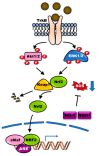Regulation of BDNF-TrkB Signaling and Potential Therapeutic Strategies for Parkinson's Disease
- PMID: 31963575
- PMCID: PMC7019526
- DOI: 10.3390/jcm9010257
Regulation of BDNF-TrkB Signaling and Potential Therapeutic Strategies for Parkinson's Disease
Abstract
Brain-derived neurotrophic factor (BDNF) and its receptor tropomyosin-related kinase receptor type B (TrkB) are widely distributed in multiple regions of the human brain. Specifically, BDNF/TrkB is highly expressed and activated in the dopaminergic neurons of the substantia nigra and plays a critical role in neurophysiological processes, including neuro-protection and maturation and maintenance of neurons. The activation as well as dysfunction of the BDNF-TrkB pathway are associated with neurodegenerative diseases. The expression of BDNF/TrkB in the substantia nigra is significantly reduced in Parkinson's Disease (PD) patients. This review summarizes recent progress in the understanding of the cellular and molecular roles of BNDF/TrkB signaling and its isoform, TrkB.T1, in Parkinson's disease. We have also discussed the effects of current therapies on BDNF/TrkB signaling in Parkinson's disease patients and the mechanisms underlying the mutation-mediated acquisition of resistance to therapies for Parkinson's disease.
Keywords: BDNF; Parkinson’s disease; TrkB; TrkB isoform; neuronal degeneration.
Conflict of interest statement
The author declares no conflict of interest.
Figures




Similar articles
-
BDNF/TrkB activators in Parkinson's disease: A new therapeutic strategy.J Cell Mol Med. 2024 May;28(10):e18368. doi: 10.1111/jcmm.18368. J Cell Mol Med. 2024. PMID: 38752280 Free PMC article. Review.
-
BDNF-Regulated Modulation of Striatal Circuits and Implications for Parkinson's Disease and Dystonia.Biomedicines. 2024 Aug 5;12(8):1761. doi: 10.3390/biomedicines12081761. Biomedicines. 2024. PMID: 39200225 Free PMC article. Review.
-
Expression of full-length and truncated trkB in human striatum and substantia nigra neurons: implications for Parkinson's disease.J Mol Histol. 2014 Jun;45(3):349-61. doi: 10.1007/s10735-013-9562-z. Epub 2013 Dec 29. J Mol Histol. 2014. PMID: 24374887
-
ERRγ ligand HPB2 upregulates BDNF-TrkB and enhances dopaminergic neuronal phenotype.Pharmacol Res. 2021 Mar;165:105423. doi: 10.1016/j.phrs.2021.105423. Epub 2021 Jan 9. Pharmacol Res. 2021. PMID: 33434621
-
Hydroxysafflor Yellow A Improves Motor Dysfunction in the Rotenone-Induced Mice Model of Parkinson's Disease.Neurochem Res. 2017 May;42(5):1325-1332. doi: 10.1007/s11064-017-2176-1. Epub 2017 Jan 17. Neurochem Res. 2017. PMID: 28097465
Cited by
-
Flavonoids against depression: a comprehensive review of literature.Front Pharmacol. 2024 Oct 16;15:1411168. doi: 10.3389/fphar.2024.1411168. eCollection 2024. Front Pharmacol. 2024. PMID: 39478958 Free PMC article. Review.
-
Environment and Gene Association With Obesity and Their Impact on Neurodegenerative and Neurodevelopmental Diseases.Front Neurosci. 2020 Aug 28;14:863. doi: 10.3389/fnins.2020.00863. eCollection 2020. Front Neurosci. 2020. PMID: 32982666 Free PMC article. Review.
-
Unveiling the LncRNA-miRNA-mRNA Regulatory Network in Arsenic-Induced Nerve Injury in Rats through High-Throughput Sequencing.Toxics. 2023 Nov 22;11(12):953. doi: 10.3390/toxics11120953. Toxics. 2023. PMID: 38133354 Free PMC article.
-
Cerebellar Calcium-Binding Protein and Neurotrophin Receptor Defects in Down Syndrome and Alzheimer's Disease.Front Aging Neurosci. 2021 Mar 12;13:645334. doi: 10.3389/fnagi.2021.645334. eCollection 2021. Front Aging Neurosci. 2021. PMID: 33776745 Free PMC article.
-
Characterization of exosomal microRNAs in preterm infants fed with breast milk and infant formula.Front Nutr. 2024 Jan 18;11:1339919. doi: 10.3389/fnut.2024.1339919. eCollection 2024. Front Nutr. 2024. PMID: 38304545 Free PMC article.
References
Publication types
LinkOut - more resources
Full Text Sources
Other Literature Sources

